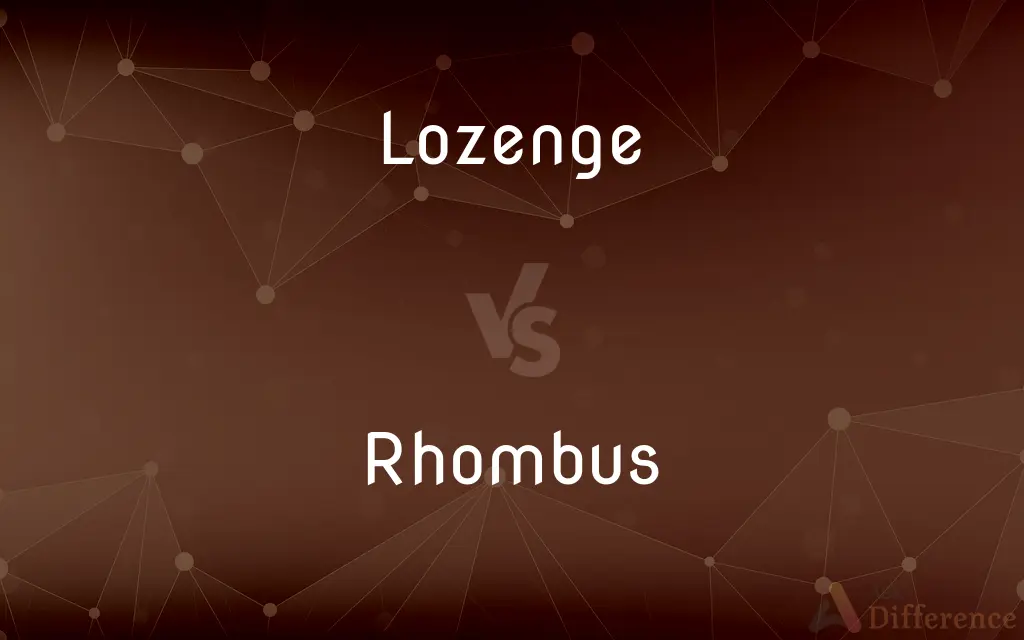Lozenge vs. Rhombus — What's the Difference?
Edited by Tayyaba Rehman — By Maham Liaqat — Updated on March 26, 2024
A lozenge is a diamond-shaped figure used in various contexts, while a rhombus is a parallelogram with four equal sides in geometry.

Difference Between Lozenge and Rhombus
Table of Contents
ADVERTISEMENT
Key Differences
A lozenge, often seen in design, heraldry, and pharmaceutical tablets, is shaped like a diamond or a slightly squeezed square turned on its side. In contrast, a rhombus is strictly a mathematical figure, defined in geometry as a parallelogram with all four sides of equal length, distinguishing it through its properties of equal sides and opposite equal angles.
While lozenges appear in everyday objects and symbols, conveying various meanings depending on the context, rhombuses are studied for their geometric properties, including the relationships between their sides, angles, and diagonals. This mathematical focus differentiates a rhombus from the more broadly used lozenge.
The use of a lozenge shape can be symbolic, representing clarity, precision, or other attributes in logos and artwork. On the other hand, a rhombus serves as a subject of study in mathematics, particularly in understanding concepts of symmetry, tessellation, and vector addition.
In practical applications, lozenges are also associated with medicinal tablets of a diamond shape, aimed at easing throat discomfort. Meanwhile, the principles of a rhombus find applications in architecture, art, and design, where its geometric properties are utilized for aesthetic and structural purposes.
Despite their visual similarity, the context in which a lozenge and a rhombus are used marks a clear distinction between them: one being a versatile symbol across various fields, and the other a specific mathematical figure with defined geometric properties.
ADVERTISEMENT
Comparison Chart
Definition
A diamond-shaped figure used in design, heraldry, and as a form of tablets.
A parallelogram with four equal sides in geometry.
Context of Use
Broad, including design, symbols, and pharmaceuticals.
Strictly mathematical and geometric.
Symbolism
Can symbolize various concepts depending on context.
Represents geometric principles and properties.
Properties
Shape can vary slightly; primarily defined by its visual form.
Defined by equal sides and opposite equal angles.
Practical Application
Found in everyday objects, symbols, and medication tablets.
Used in mathematical education, architecture, and design.
Compare with Definitions
Lozenge
Versatile in application.
Lozenges appeared throughout the art installation in various forms.
Rhombus
Basis for architectural design.
The building's facade featured a rhombus pattern.
Lozenge
Symbolic in heraldry.
The family crest featured a red lozenge in the center.
Rhombus
Used in tessellations.
She created a beautiful tessellation using only the shape of a rhombus.
Lozenge
Shape of certain tablets.
She preferred the cough drops that came in a lozenge shape.
Rhombus
A parallelogram with equal sides.
The students learned how to calculate the area of a rhombus.
Lozenge
Used in logos.
The company's logo was a simple green lozenge.
Rhombus
Studied in geometry.
A rhombus is a perfect example of rotational symmetry.
Lozenge
A diamond-shaped figure.
The lozenge pattern was prominent in the wallpaper design.
Rhombus
Explored in art.
His abstract paintings often incorporated rhombuses in a complex interplay of shapes.
Lozenge
A lozenge ( ), ◊ – often referred to as a diamond – is a form of rhombus. The definition of lozenge is not strictly fixed, and it is sometimes used simply as a synonym (from the French: losange) for rhombus.
Rhombus
In plane Euclidean geometry, a rhombus (plural rhombi or rhombuses) is a quadrilateral whose four sides all have the same length. Another name is equilateral quadrilateral, since equilateral means that all of its sides are equal in length.
Lozenge
A small, medicated candy intended to be dissolved slowly in the mouth to lubricate and soothe irritated tissues of the throat.
Rhombus
A quadrilateral all of whose sides have the same length.
Lozenge
A four-sided planar figure with a diamondlike shape; a rhombus that is not a square.
Rhombus
An equilateral parallelogram, especially one having oblique angles. Also called rhomb.
Lozenge
Something having this shape, especially a heraldic device.
Rhombus
(geometry) A parallelogram having all sides of equal length.
Lozenge
A quadrilateral with sides of equal length (rhombus), having two acute and two obtuse angles.
Rhombus
The rhombus diamond, as one of the suits seen in a deck of playing cards (♦ or ♦).
Lozenge
A small tablet (originally diamond-shaped) or medicated sweet used to ease a sore throat.
Rhombus
In early Greek religion, an instrument whirled on the end of a string similar to a bullroarer.
Lozenge
(transitive) To form into the shape of a lozenge.
Rhombus
Any of several flatfishes, including the brill and turbot, once considered part of the genus Rhombus, now in Scophthalmus.
Lozenge
(transitive) To mark or emblazon with a lozenge.
Rhombus
Snails, now in genus Conus or family Conidae.
Lozenge
A diamond-shaped figure usually with the upper and lower angles slightly acute, borne upon a shield or escutcheon. Cf. Fusil.
Rhombus
Same as Rhomb, 1.
Lozenge
A figure with four equal sides, having two acute and two obtuse angles; a rhomb.
Rhombus
A parallelogram with four equal sides; an oblique-angled equilateral parallelogram
Lozenge
Anything in the form of lozenge.
Lozenge
A small cake of sugar and starch, flavored, and often medicated. - originally in the form of a lozenge.
Lozenge
A small aromatic or medicated candy
Lozenge
A dose of medicine in the form of a small pellet
Common Curiosities
Can a lozenge be considered a rhombus?
In geometry, a lozenge can be considered a type of rhombus if it has four equal sides and follows the geometric rules of a rhombus.
How is a lozenge used in heraldry?
In heraldry, a lozenge is often used as a shape for shields or as a charge, symbolizing various familial or individual attributes.
What geometric principles can be studied using a rhombus?
A rhombus helps in understanding concepts like symmetry, parallelism, and the properties of parallelograms, including angles, sides, and diagonals.
Are all rhombuses lozenges?
In a mathematical context, yes, all rhombuses could be considered lozenges due to their diamond shape, but not all lozenges in everyday use strictly adhere to the geometric properties of a rhombus.
Why might a logo use a lozenge shape?
A lozenge shape in logos can convey attributes like clarity, precision, and uniqueness, making it a popular choice for branding.
What educational value does studying a rhombus have?
Studying a rhombus introduces students to fundamental geometric concepts, enhancing their understanding of shapes, angles, and properties of space.
How does the context change the interpretation of a lozenge vs. a rhombus?
The interpretation changes based on context: in everyday and symbolic uses, a lozenge conveys various meanings, while in geometry, a rhombus is appreciated for its precise properties and applications.
Is the lozenge shape common in pharmaceuticals?
Yes, the lozenge shape is common for certain types of medicinal tablets, especially throat lozenges, due to ease of use and manufacturing.
How do artists use the shape of a rhombus?
Artists may use the rhombus shape to explore symmetry, balance, and geometric beauty in their works, incorporating it into patterns or as a fundamental design element.
What makes a lozenge different from a rhombus?
A lozenge is broadly used across various contexts and can symbolize different things, whereas a rhombus is specifically a mathematical shape with defined geometric properties.
Share Your Discovery

Previous Comparison
Slander vs. Gossip
Next Comparison
Competence vs. IntentionAuthor Spotlight
Written by
Maham LiaqatEdited by
Tayyaba RehmanTayyaba Rehman is a distinguished writer, currently serving as a primary contributor to askdifference.com. As a researcher in semantics and etymology, Tayyaba's passion for the complexity of languages and their distinctions has found a perfect home on the platform. Tayyaba delves into the intricacies of language, distinguishing between commonly confused words and phrases, thereby providing clarity for readers worldwide.














































